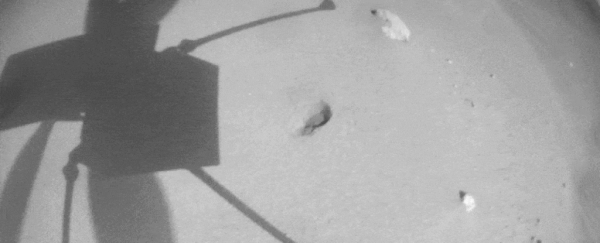When Mars helicopter Ingenuity was packed off on a one-way trip to the red planet, its engineers had a plan for five flights.
That didn't mean more flights were not on the cards; in fact, it's normal for NASA's spacecraft mission parameters to be set conservatively. But late last year, NASA extended the mission indefinitely, and the little helicopter that could has now blown past its initial objectives: It completed a milestone 25 flights in the thin, tenuous Martian atmosphere.
Actually, it has completed 28 flights at time of writing, but Flight 25 was an absolute corker. On 8 April, when the flight took place, Ingenuity broke records for both distance and speed, soaring 704 meters (2,310 feet) and up to 5.5 meters per second (12 mph).
And it sent home images, which its handlers have now stitched together into a video, showing a robotic helicopter's-eye view of a flight across Mars.
"For our record-breaking flight, Ingenuity's downward-looking navigation camera provided us with a breathtaking sense of what it would feel like gliding 33 feet above the surface of Mars at 12 miles per hour," said engineer and Ingenuity team lead Teddy Tzanetos of NASA's Jet Propulsion Laboratory.
The duration of the flight was 161.3 seconds, but the helicopter didn't start taking images until about one second in. That's because Ingenuity uses its camera for navigation; it doesn't switch on until the helicopter reaches an altitude of about 1 meter, to avoid the camera being confused by dust kicked up at takeoff or landing.
In the video, Ingenuity rises to an altitude of 33 meters before accelerating towards the southwest. It reaches its maximum speed of 5.5 meters per second within three seconds. First, the helicopter flies over some rippling sand, then over rocky fields, followed by relatively flat and featureless ground, on which Ingenuity could make a safe landing.
These flight parameters were pre-set, and sent to Ingenuity by the helicopter's team of pilots on the ground. Once in the air (such as it is), Ingenuity is on its own; the time lag between Earth and Mars means that no mid-course corrections can be taken.
This means that the occasional mishap can occur, like one we saw a year ago, when a glitch in the helicopter's image processing pipeline led to a lag between what Ingenuity was seeing, and where it actually was in real time. Thankfully, built-in failsafes allowed Ingenuity to land safely so that NASA engineers could issue a patch prior to the next flight.
Since then, it's been pretty smooth flying, even in very alien atmospheric conditions to those here on Earth, and the little helicopter shows no sign of slowing. Mars' atmospheric volume is less than 1 percent of Earth's; we still marvel, with every flight, that humans managed to build something that can fly in it. Ingenuity, indeed!
